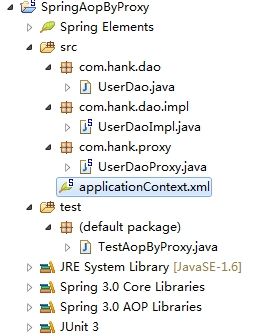spring-AOP实现方式(2----自动代理的AOP实现)
Spring的AOP实现方式----二:
自动代理的AOP实现
代码和上一篇基于代理的AOP实现是一样的。只是配置文件和测试类有点变化
经典的基于代理的AOP实现,思路整理如下:
1、创建具体的实现类(被代理类bean),同时要在applicationContext.xml中进行相应配置
2、创建代理类,根据需要实现对应的如下接口中的一种或几种,同时也要在applicationContext.xml中进行相应配置
Spring支持五种类型的通知:
1、Before(前) org.apringframework.aop.MethodBeforeAdvice
2、After-returning(返回后) org.springframework.aop.AfterReturningAdvice
3、After-throwing(抛出后) org.springframework.aop.ThrowsAdvice
4、Arround(周围) org.aopaliance.intercept.MethodInterceptor
5、Introduction(引入) org.springframework.aop.IntroductionInterceptor
3、定义正则表达式的通知
4、定义一个表示声明使用自动代理的类
注:这里的AOP实现的动态代理和java的动态代理原理基本差不多,所以具体的被代理类,要实现一个接口,只能通过接口进行代理,不能通过类进行代理;注意测试类中的获取bean和基于代理的AOP实现获取方式不同[/b][/color]
具体实现如下:
代码结构如图:

被代理的具体的类:
被代理类实现的接口类
代理类,即拦截处理类
配置文件
测试类,运用junit进行测试
输入结果:
log4j:WARN No appenders could be found for logger (org.springframework.context.support.ClassPathXmlApplicationContext).
log4j:WARN Please initialize the log4j system properly.
方法执行之前。。。。。。
保存用户信息。。。。。。
方法执行之后。。。。。
自动代理的AOP实现
代码和上一篇基于代理的AOP实现是一样的。只是配置文件和测试类有点变化
经典的基于代理的AOP实现,思路整理如下:
1、创建具体的实现类(被代理类bean),同时要在applicationContext.xml中进行相应配置
<!-- 1.定义被代理类bean --> <bean id="userDaoImpl" class="com.hank.dao.impl.UserDaoImpl"/>
2、创建代理类,根据需要实现对应的如下接口中的一种或几种,同时也要在applicationContext.xml中进行相应配置
Spring支持五种类型的通知:
1、Before(前) org.apringframework.aop.MethodBeforeAdvice
2、After-returning(返回后) org.springframework.aop.AfterReturningAdvice
3、After-throwing(抛出后) org.springframework.aop.ThrowsAdvice
4、Arround(周围) org.aopaliance.intercept.MethodInterceptor
5、Introduction(引入) org.springframework.aop.IntroductionInterceptor
<!-- 2.定义代理类 --> <bean id="userDaoProxy" class="com.hank.proxy.UserDaoProxy"/>
3、定义正则表达式的通知
4、定义一个表示声明使用自动代理的类
注:这里的AOP实现的动态代理和java的动态代理原理基本差不多,所以具体的被代理类,要实现一个接口,只能通过接口进行代理,不能通过类进行代理;注意测试类中的获取bean和基于代理的AOP实现获取方式不同[/b][/color]
具体实现如下:
代码结构如图:

被代理的具体的类:
package com.hank.dao.impl;
import com.hank.dao.UserDao;
public class UserDaoImpl implements UserDao{
public void saveUser() {
System.out.println("保存用户信息。。。。。。");
}
public void queryUser() {
System.out.println("查看用户信息。。。。。。");
}
}
被代理类实现的接口类
package com.hank.dao;
public interface UserDao {
//保存用户信息
public void saveUser();
//查看用户信息
public void queryUser();
}
代理类,即拦截处理类
package com.hank.proxy;
import java.lang.reflect.Method;
import org.springframework.aop.AfterReturningAdvice;
import org.springframework.aop.MethodBeforeAdvice;
public class UserDaoProxy implements MethodBeforeAdvice, AfterReturningAdvice{
public void afterReturning(Object arg0, Method arg1, Object[] arg2,
Object arg3) throws Throwable {
System.out.println("方法执行之后。。。。。");
}
public void before(Method method, Object[] args, Object target)
throws Throwable {
System.out.println("方法执行之前。。。。。。");
}
}
配置文件
<?xml version="1.0" encoding="UTF-8"?> <beans xmlns="http://www.springframework.org/schema/beans" xmlns:xsi="http://www.w3.org/2001/XMLSchema-instance" xmlns:p="http://www.springframework.org/schema/p" xsi:schemaLocation="http://www.springframework.org/schema/beans http://www.springframework.org/schema/beans/spring-beans-3.0.xsd"> <!-- 1.定义具体被代理类 --> <bean id="userDaoImpl" class="com.hank.dao.impl.UserDaoImpl"/> <!-- 2.定义代理类 --> <bean id="userDaoProxy" class="com.hank.proxy.UserDaoProxy"/> <!-- 3.定义支持正则表达式的通知 --> <bean id="userDaoAdvisor" class="org.springframework.aop.support.RegexpMethodPointcutAdvisor"> <property name="advice" ref="userDaoProxy"></property> <property name="pattern" value=".*User"></property> </bean> <!-- 4.定义一个表示声明使用自动代理的类 --> <bean class="org.springframework.aop.framework.autoproxy.DefaultAdvisorAutoProxyCreator"/> </beans>
测试类,运用junit进行测试
import org.springframework.context.ApplicationContext;
import org.springframework.context.support.ClassPathXmlApplicationContext;
import com.hank.dao.UserDao;
import junit.framework.TestCase;
public class TestAopByAutoProxy extends TestCase{
public void test1() {
ApplicationContext ctx = new ClassPathXmlApplicationContext("applicationContext.xml");
UserDao userDao = (UserDao)ctx.getBean("userDaoImpl");
userDao.saveUser();
}
}
输入结果:
log4j:WARN No appenders could be found for logger (org.springframework.context.support.ClassPathXmlApplicationContext).
log4j:WARN Please initialize the log4j system properly.
方法执行之前。。。。。。
保存用户信息。。。。。。
方法执行之后。。。。。